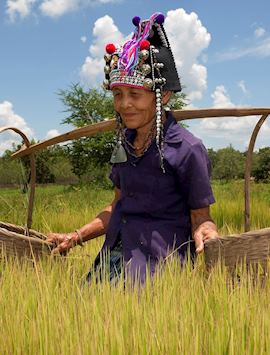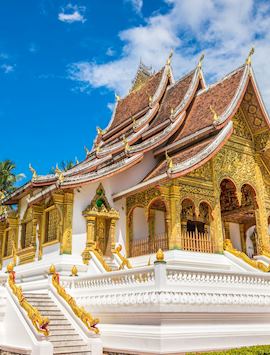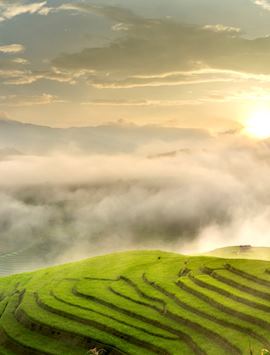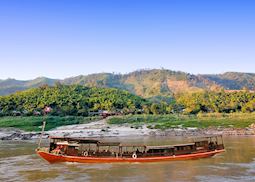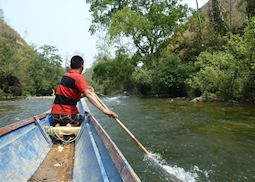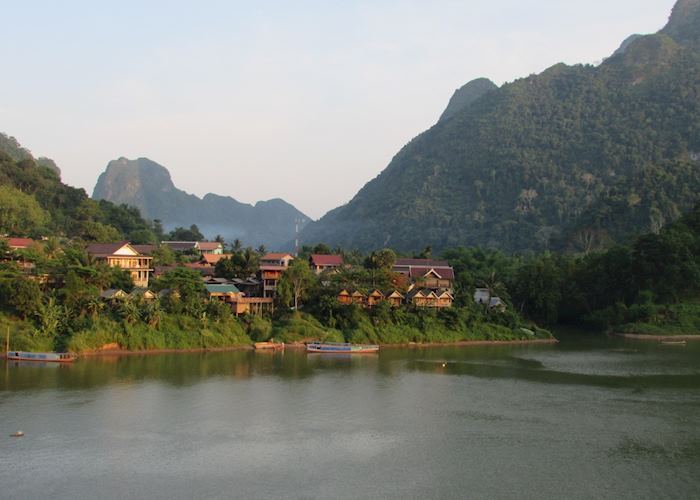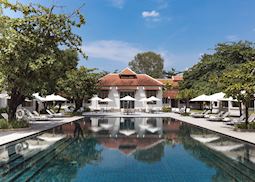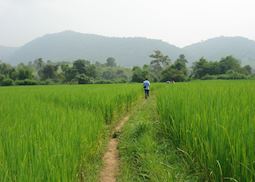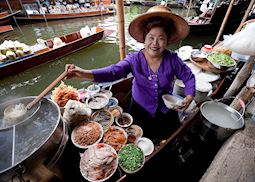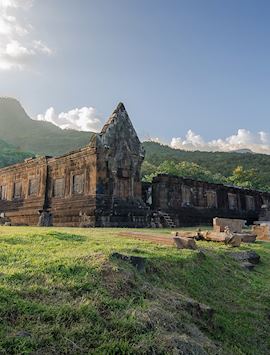
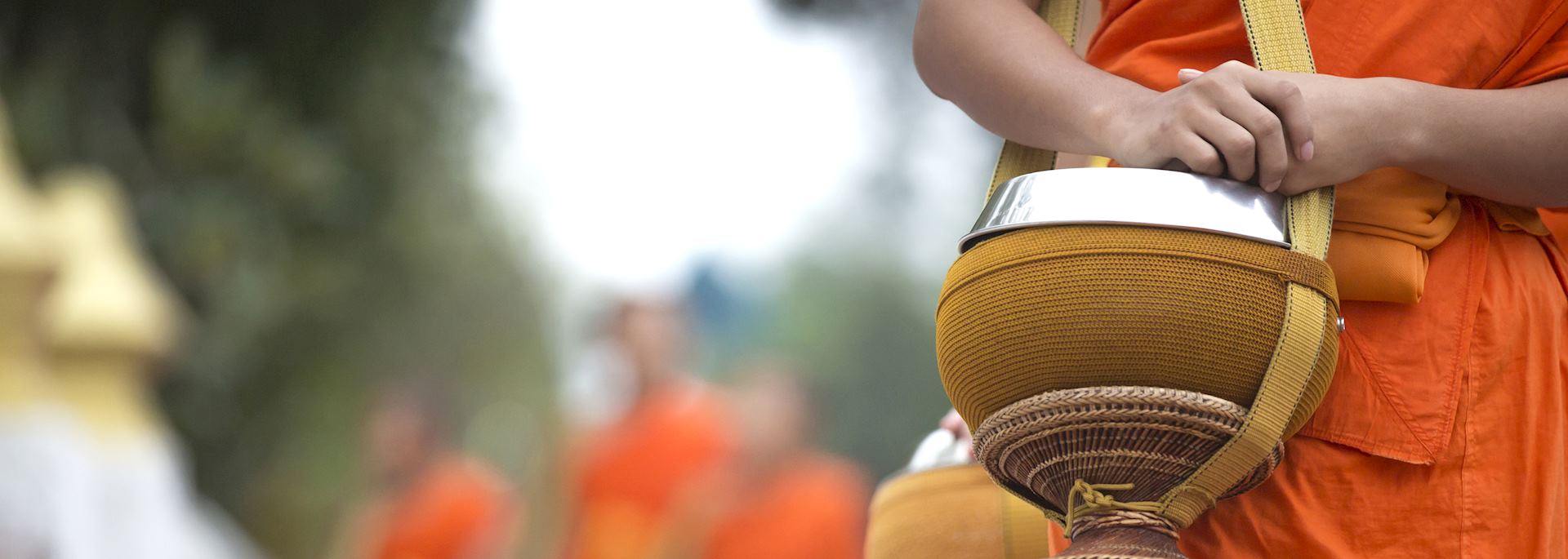
Tailor-made Laos holidays shaped around your passions
Laos is one of the few destinations where, in some areas, visitors are yet to deviate from a few well-trodden sights. Our specialists have trekked through jungles, scouted out caves and journeyed up rivers to get to know it more intimately. They can help you plan your holiday to Laos to follow in their wake.
Only now emerging after years of isolation, Laos is a country of steep, jungle-robed valleys inhabited by resilient communities who live at a refreshingly unhurried pace. The former royal stronghold, Luang Prabang, is a mosaic of golden wats and French colonial-era villas, its streets often filled with silent processions of monks. In the diminutive capital, Vientiane, you’ll find faded mansions and coffee shops. The rest of the country is predominantly one blanket of green, carved with slow-flowing tributaries of the Mekong. As you explore, you’ll happen upon little-visited hill tribes, backwater towns and Cham temples that predate Cambodia’s Angkor Wat.
Suggested tours for Laos
These tours give you a starting point for what your holiday to Laos could entail. Treat them as inspiration, as each trip is created uniquely for you.
Suggested activities for Laos
Whatever your interests, our specialists will build activities into your trip that connect to how you want to experience Laos.
-
Luang Say cruise ![Luang Say Cruise]()
Luang Say cruise
Luang Say cruise
One of the best ways to enter Laos is by river from the Thai border. The journey takes you through surprisingly varied scenery, from remote 6,000 foot mountains to lunar rock faces and sandbanks.
View details -
Nam Nern night safari ![Nam Nern Night Safari]()
Nam Nern night safari
Nam Et-Phou LoueyNam Nern night safari
Located in the only accessible area of the remote Nam Et-Phou Louey National Park in northeastern Laos, the Nam Nern Night Safari provides one of the few opportunities in Laos to view rare wildlife. This tour has been designed to create a direct link between conservation and tourism so that the money you pay has a positive impact on encouraging local people to protect endangered tigers and other wildlife.
View details -
Wat Phou rice barge ![Wat Phou Cruise in the 4000 islands]()
Wat Phou rice barge
4,000 IslandsWat Phou rice barge
This sympathetically converted rice barge cruises between Pakse and the Four Thousand Islands area of southern Laos.
View details
Why travel with Audley?
- 100% tailor-made tours
- Fully protected travel
- Established for over 25 years
- 98% of our clients would recommend us
Best time to visit
Our specialists advise on the best months to visit Laos, including information about climate, events and festivals.
Request our brochure
Covering all seven continents, The World Your Way shows you how you can see the world with us. It features trip ideas from our specialists alongside hand-picked stays and experiences, and introduces our approach to creating meaningful travel experiences.
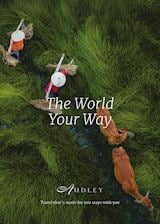
Useful information for planning your holiday in Laos
The official language of Laos is Lao, a tonal language similar to that spoken in Northern Thailand. As a result of former colonisation, French is still taught in schools, but English is now spoken more widely, especially by the younger generation.
Although the complex tonal variations in Lao can make it difficult for English speakers to pronounce words accurately, any attempt by farangs (foreigners) to speak Lao is always appreciated. People from Laos often greet each other by smiling, pressing together their palms, and saying ‘sabaidee’ which means hello.
The currency of Laos is the Laotian kip (LAK). The kip is a closed currency and cannot be taken out of the country, so you’ll need to find an ATM on arrival or visit a bank or money exchange to get local cash. ATMs are commonplace and most hotels, shops, and markets in Vientiane and Luang Prabang will also accept Thai baht and US dollars. Credit cards are widely accepted in most hotels, gift shops, and upmarket restaurants.
When in Laos, you should try larb (minced pork salad), tam mak hoong (green papaya salad), and mok pa (steamed fish parcels). Rice, especially sticky rice, is the staple food and most Lao dishes will have an Indo-Chinese influence. You’ll find the most authentic local food on market stalls and in smaller restaurants where local people eat. The influence of former French colonisation is still seen in the baguettes and croissants normally eaten for breakfast, while lao lao (rice whisky) and Beer Lao are the most common drinks.
Tipping is commonplace in Laos, especially in the service industry, and a tip of about 10% is appreciated. You should also be prepared to tip guides, drivers, and porters. We use the best guides and drivers available in Laos, but as there are limited guide numbers, the best guides do expect larger tips than might be expected in other countries. We can provide more details before you travel.
Plan to dress modestly in Laos with clothes that cover your shoulders and knees, particularly if visiting temples or Luang Prabang, one of Southeast Asia's most spiritual destinations. You’ll also be asked to remove your shoes and leave them outside when entering a temple.
During the drier months (October to April), you’ll need light clothing such as shorts, skirts, and shirts, and possibly a fleece for the evenings. In the rainy season (May to September), a light waterproof jacket is useful, as well as clothes with long legs and sleeves to wear during dusk and dawn when mosquitoes are active.
A sun hat and umbrella, which can double up as a parasol, are always useful.
For the latest travel advice for Laos, including entry requirements, health information, and the safety and security situation, please refer to the Foreign, Commonwealth & Development Office website.
In Laos, you can visit gilded temples, admire dramatic karst scenery and forested mountains, and immerse yourself in local traditions and cultures, such as alms giving in Luang Prabang.
You could also experience what it’s like to work in a rice paddy, take a cookery class to learn all about local ingredients and culinary traditions, or set out along the Mekong on a river cruise.
For a more adventurous trip, you could get out into the jungle-clad hills and mountains on a caving and kayaking tour or go on a guided hiking trip to the 100 waterfalls.
Laos offers a wide range of places to stay from stylish boutique hotels to restored French villas and ecolodges in the mountains of the north. You’ll find the best choice of hotels in Luang Prabang and Vientiane where you can stay in a former royal residence with a spa and choice of swimming pools, or a historical former officers’ residence turned sleek, minimalist hotel. Outside the cities, and in the south, hotels are often simpler but comfortable and may have more traditional styling, but our specialists have found plenty of interesting options from simple guesthouses on the banks of the Mekong to traditional thatched bungalows set in tropical gardens.
Luang Prabang, Vientiane, and Vang Vieng are some of the best places to go in Laos, but you’ll also find plenty to explore in the lush hills of the far north and the small villages and temple ruins of the south. You could watch saffron-robed monks collect alms among gilded temples in the UNESCO World Heritage town of Luang Prabang, visit caves and small villages in the dramatic limestone karst scenery around Vang Vieng, or explore the mysterious Plain of Jars where hundreds of giant urn-like stones dating back to megalithic times lie strewn across the plains. Hike through the mountains of the north from a base in Nong Khiaw or watch freshwater dolphins in the Mekong and enjoy the slow pace of rural life in the 4000 Islands. Our country specialists will be happy to discuss your interests and offer advice on the best places to go in Laos.
It takes around 16 and a half hours to fly from the UK to Laos, usually with a stopover in Bangkok.
The time zone in Laos is UTC+7 hours. Laos does not observe Daylight Savings Time.
Train travel is one of the best ways of getting around northern Laos, while domestic flights are best for travel between the north and the south. The train is comfortable and reliable and links the capital, Vientiane, with Vang Vieng, Luang Prabang, and further north. River travel is also possible in Laos, and boat journeys along the Mekong River allow you to visit remote communities in the hills more easily. Alternatively, we can arrange for you to have a private driver between destinations.
Your doctor can provide you with vaccine advice for Laos. You can also check the suggested vaccinations on the Travel Health Pro website. Ensuring you’re up to date with recommended vaccinations at home before setting off on any trip is also a good idea.
If you’re travelling to Laos from a country that is considered to have a risk of yellow fever by the World Health Organization (WHO), then you may be asked to provide proof of vaccination against the disease upon arrival. Consult your doctor for up-to-date advice.
Use our travel tool to find up-to-date visa and passport requirements for Laos. Enter where you’re travelling to and from (including any stopover destinations en route or flight layovers), along with your intended travel dates and passport details, for a full list of requirements.
Laos in pictures
Our expert guides to travelling in Laos
Written by our specialists from the viewpoint of their own travels, these guides will help you decide on the shape of your own trip to Laos. Aiming to inspire and inform, we share our recommendations for how to appreciate Laos at its best.
-
![Laos: why you should go]()
Laos: why you should go
-
Luxury holidays in Laos ![Swimming pool, Amantaka]()
Luxury holidays in Laos
Luxury holidays in Laos
If you're planning a luxury holiday to Laos we have a wide range of accommodation available. Our specialists can recommend the best places to stay to ensure you have a trip to remember.
Read this guide -
Exploring the far north of Laos ![Laos tribal women]()
Exploring the far north of Laos
Exploring the far north of Laos
Visiting Laos is an opportunity to escape from the fast-paced lifestyle of the developed world, especially northern Laos. Soak up the tranquil atmosphere and admire the picturesque scenery of this little-visited area.
Read this guide -
What to do in Laos: our highlights guide ![Mekong River]()
What to do in Laos: our highlights guide
What to do in Laos: our highlights guide
Still very much untouched by mass tourism, Laos offers the visitor much to see and do, from watching monks perform daily rituals or taking a night safari in a national park, to learning to cook Laotian food or taking a relaxing cruise down the Mekong River.
Read this guide -
Laos walking & trekking holidays ![Walking to the H'mong village garden]()
Laos walking & trekking holidays
Laos walking & trekking holidays
Laos specialist and keen hiker Laura explains why the jungle-clad hills of northern Laos are best explored on foot. She shares her suggestions for the best routes and experiences to make the most of a walking holiday in Laos.
Read this guide







